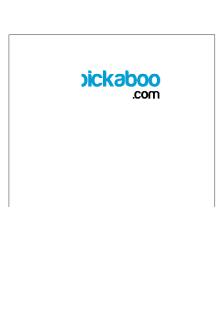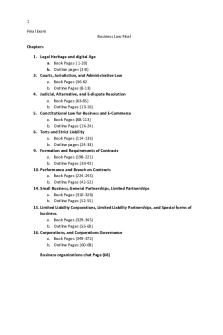Business final PDF

| Title | Business final |
|---|---|
| Course | The Business Of Health Care |
| Institution | Nova Southeastern University |
| Pages | 3 |
| File Size | 93.2 KB |
| File Type | |
| Total Downloads | 2 |
| Total Views | 158 |
Summary
Nursing Health Care Business Final Exam...
Description
Business final NHPPD: Nursing hours per patient day- amount of nursing care required per patient in a 24 hr period and is usually based on midnight census and past unit needs, expected unit practice trends, national benchmarks, professional staffing standards, and budget negotiations - Reflects only productive nursing time needed. - Ex. 20 pts on the unit. 5 staff X 3 shifts= 15 staff 15 staff each working 8 hrs= 120 hrs available in a 24 hr period. 120 nursing hours/ 20 pts = 6.0 NHPPD Types of budgets: Operational budget: accounts for the income and expenses associated with day to day activity within a department or organization. Revenue generation is based upon billable services and expenses associated with equipment, supplies, staffing and other indirect costs. Revenue may be based on the number of days the patient stays on the unit or the number of hrs spent in a procedure room. Revenue may be based on type of procedures delivered to patient. Capital Budget: allows for a purchase of a major new or replacement equipment. Equipment is purchased when new technology becomes available or when old equipment becomes too expensive to maintain. Organizations want to make the best and most economical and informed decision. Construction budget: when renovations or new structures are planned Constructions costs include labor, materials, building permits, inspections, equipment. Types of expenses: Supplies: supplies. Duh! Labor: significant expense associated with medical and nursing care. Health care services are very labor expensive. Salaries and benefits account for 50-60 % of operational costs. Analysis includes professional, technical and support staff. Staffing: the amount of staff and types of staff are often accounted for in a staffing model. The model outlines the number of staff required based upon the primary statistic such as procedures or patients. Unproductive time: circulated into a budget because there has to be staff coverage when nurses or other staff members are not working. Usually includes sick, vacation, personal, and education time. Productive time: hours worked and available for patient care Variance: difference between what was budgeted and the actual result FTE: Full time equivalent- measure of the work commitment of an employee who works five days a week or 40 hrs per week for 52 weeks a year. Employee who works 40 hrs a week= 1.0 full time Employee who works 36 hrs (three 12 hr shifts)= 0.9 is considered full time in many agencies for benefit purposes Part time employee who works 5 days a week in a 2 week period is considered a 0.5
Models of care delivery
Organizes the work of caring for pts
Case method: oldest model for nursing care delivery Nurse cares for one pt exclusively. Ex what is total pt care now days
Total patient care: the nurse is responsible for the total care of the pt Advantages: Consistency of one individual caring for pt for entire shift. Develops a trusting relationship Nurse has more opportunity to observe and care for pt
Disadvantages: Provides higher number of RN hours of care More costly than other methods Model Works well in specialized units like hospice
Functional nursing: became popular during world war II when there was a significant shortage of nurses Allowed UAP and LPN to carry over activities that where usually carried out by RN Divides the nursing work into functional roles that are then assigned to one of the team members. Each care provider has specific duties or tasks Technical rather than professional care results from this model Advantages: Care can be delivered to a large number of patients. System utilizes other types of health care workers when there is a shortage of RNs Pts have care delivered in one shift by more than one person Disadvantage: Care may feel disjointed to a pt Communication blocks Team Nursing: is a care delivery model that assigns staff to teams that then are responsible for a group of patients. A unit may be divided in 2 teams and each team led by an RN The team leader supervises and coordinates all the care provided by those on the team Team most commonly made up of UAP and LPN Team leader responsible for safely delegating specific duties to the team The larger the team the more the RN is stretched to safely monitor and care for the pts. RN needs very good delegation and supervision skills. Modular nursing: type of team nursing that divides a geographic space into modules of pts, with each model cared for by a team or staff led by an RN Advantages: RN is able to get work done through others. Disadvantages: Pts usually receive fragmented, depersonalized care. Communication is complex Shared responsibility and accountability can cause confusion and lack of accountability Primary nursing: the RN is the primary provider of care to patients.
Primary nurse must retain 24 hrs of accountability for care coordination for a set of pts throughout the pts hospital stay. They are responsible for developing pt plan of care Nurses and pts are matched according to needs and ability Nurse to pt ratios must be realistic
Advantages: pt and families are able to develop a trusting relationship Holistic approach rather than a shift to shift approach Nurses find this model professionally rewarding bc they get to spend time with their pt and decision making at bedside Disadvantages: High cost $$ bc there is a higher RN skill mix Nurse may b required to travel long distance Nurses usually perform function that could be done by others Patient centered care or patient focused care: designed to focus on pt needs rather than staff needs Required care is brought to pt Staffing is based on pt needs. Effort to have the right person doing the right thing Care trams are established for a group of pts Care team may include resp, physical therapist Advantages Most convenient for pts and expedite services to pts Disadvantages: Costly to decentralize major services in an organization Staff has perceived the model as way to cut down RN and budget costs in the hospital...
Similar Free PDFs

Business final
- 3 Pages

Business ethics final assesment
- 4 Pages

FINAL BUSINESS PLAN 1
- 16 Pages

Business Plan Final
- 8 Pages

Business plan (SPCC) Final
- 55 Pages

Essay-final - Business
- 3 Pages

Business English-Final
- 37 Pages

Business Model Canvas - Final
- 4 Pages

Pickaboo-E-business Final
- 26 Pages

BUSINESS PLAN final
- 47 Pages

Business- Ethics-Q4- Final
- 19 Pages

11. Country Business Final
- 14 Pages

Business LAW Final EXAM
- 70 Pages

Final Essay- Internation business
- 17 Pages

Business Plan Final
- 21 Pages

BUSINESS RESEARCH FINAL-v1.
- 80 Pages
Popular Institutions
- Tinajero National High School - Annex
- Politeknik Caltex Riau
- Yokohama City University
- SGT University
- University of Al-Qadisiyah
- Divine Word College of Vigan
- Techniek College Rotterdam
- Universidade de Santiago
- Universiti Teknologi MARA Cawangan Johor Kampus Pasir Gudang
- Poltekkes Kemenkes Yogyakarta
- Baguio City National High School
- Colegio san marcos
- preparatoria uno
- Centro de Bachillerato Tecnológico Industrial y de Servicios No. 107
- Dalian Maritime University
- Quang Trung Secondary School
- Colegio Tecnológico en Informática
- Corporación Regional de Educación Superior
- Grupo CEDVA
- Dar Al Uloom University
- Centro de Estudios Preuniversitarios de la Universidad Nacional de Ingeniería
- 上智大学
- Aakash International School, Nuna Majara
- San Felipe Neri Catholic School
- Kang Chiao International School - New Taipei City
- Misamis Occidental National High School
- Institución Educativa Escuela Normal Juan Ladrilleros
- Kolehiyo ng Pantukan
- Batanes State College
- Instituto Continental
- Sekolah Menengah Kejuruan Kesehatan Kaltara (Tarakan)
- Colegio de La Inmaculada Concepcion - Cebu